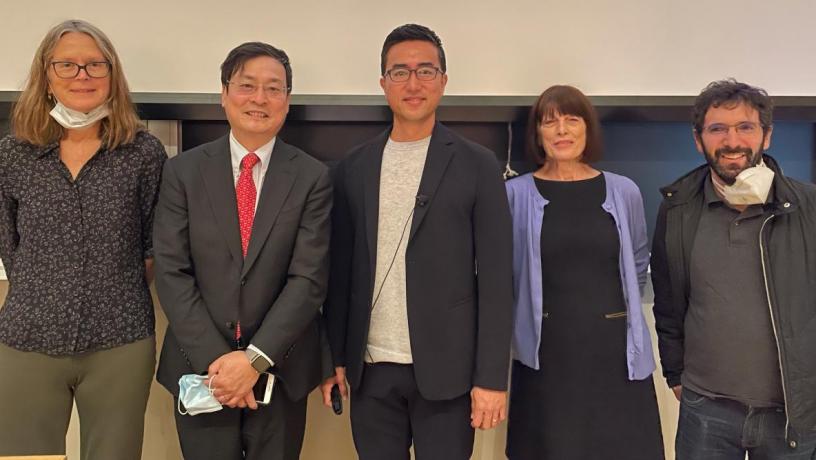Event Recap: BME Seminar - Dan Huh, University of Pennsylvania
BME SEMINAR SERIES

Dr. Dan Huh’s organ-on-a-chip technologies may be on the micro- and nanoscale in size, but they’re a big deal. Huh was the latest speaker in the BME Seminar Series on Friday, October 29. With his many examples of organ-on-a-chip platforms developed by his lab, Huh painted a picture of an impressive future in which these model systems revolutionize medicine.
Dan Huh is an Associate Professor in the Department of Bioengineering at the University of Pennsylvania. He pioneers organ-on-a-chip technology, and his research group at Penn focuses on developing microengineered models of human physiological systems for biomedical and environmental applications. Dr. Huh has won several honors and awards including the Bernard Langer Distinguished Lectureship, Lush Prize, the McPherson Distinguished Lectureship, CRI Technology Impact Award, John J. Ryan Medal, Design of the Year Award and Best Product of the Year Award from London Design Museum, NIH Director’s New Innovator Award, and Analytical Chemistry Young Innovator Award. In addition to his research, he co-founded a company called Vivodyne dedicated to creating an end-to-end pipeline for scaling up organ-on-a-chip technologies, translating them to the clinic, and accelerating cures to human diseases.
In his talk titled “Microengineered Biomimicry of Human Physiological Systems”, Huh illustrated how his work leverages microengineering technologies to develop advanced in vitro models capable of emulating the structural and functional complexity of human organs. His presentation included a potpourri of the organ-on-a-chip systems developed by his lab, from perfusable blood vessels, to lung tumors, to placenta-on-a-chip. Huh explained how one goes about designing and creating organ chips: first, the target organ is identified and broken down into functional units, and structure, architecture, and biochemical/mechanical cues are examined; once these features are determined, a system is designed to best replicate them and mimic complex organ-level functions. Notably, the Huh team has developed a model of a blinking eye by mimicking the ocular surface using a scaffold on which corneal and conjunctival cells differentiate into complex features. With this system, they used computational modeling to estimate physiological forces to learn more about the influence of blinking on cellular structures, and even modeled disease tissue through dry eye disease. The Huh team also developed a multi-organ model system that included a bone marrow model chip and a lung model chip, then used systemic circulation to look at how secreted cytokines from infected airway tissue cause innate immune system recruitment from the bone marrow. This system’s results were so out-of-this-world that it was sent to space to study immunosuppression in microgravity! Most recently, Huh has become excited about engineering organoids on a chip to develop more physiologically relevant models; his lab developed an OCTOPUS design that helps increase the lifespan of organoids and prevent development of a necrotic core, which is an issue that plagues the field of organoid research. With organoid-on-a-chip systems, disease models can be built to show phenomena not present in simpler, cell culture models; these platforms are therefore a step toward better representations of complex organ systems.
Organ-on-a-chip platforms like those created by the Huh team have generated a lot of excitement in the field of bioengineering and medicine, as many researchers tout how their technology advances us toward personalized treatment and better understanding of biological functions. However, despite the compelling technology, few of these promises have been fulfilled. As Huh explained, this is an “inconvenient truth” about organ-on-a-chip: the technology’s complexity makes it challenging to scale up and translate in a meaningful way. This is not to say these platforms cannot be beneficial-- they only need a little push toward automation to be useful on large scales. Huh is passionate about bringing the possibilities of organ-on-a-chip platforms to fruition, which is why he works on automating organ-on-a-chip handling and processing in parallel with the development of the platforms themselves. Huh’s work in this space highlights the importance of collaboration between basic science and engineering; labs developing these organ-on-a-chip platforms often do not have expertise in robotics, but these instruments are essential for scaling up the technology.
You can read more about the Huh lab’s research here. His exciting lecture was the latest of many in this semester’s seminar series hosted by the Department of Biomedical Engineering at Columbia University. If you are interested in attending in person or virtually, the weekly series takes place on Friday mornings at 11:00 AM Eastern and includes a variety of renowned academics from top universities to talk about their specific research and experience.
Learn more and register for the seminar series!
